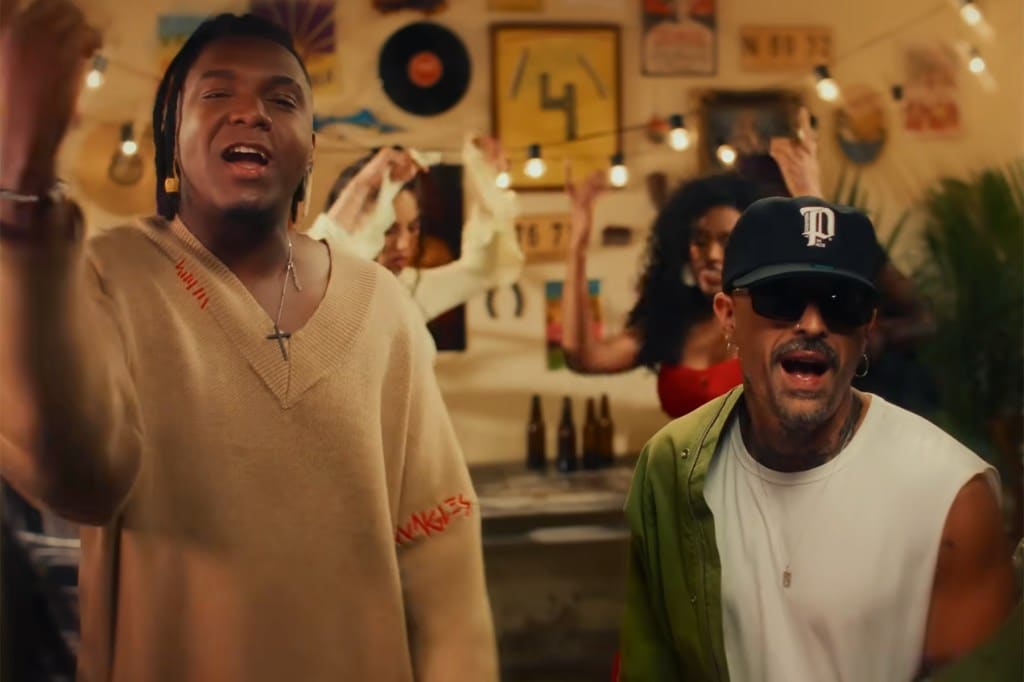billboard latin
Trending on Billboard
Venesti and Mike Bahía take “Difícile,” their first partnership, to No. 1 on Billboard’s Latin Airplay chart (dated Nov. 22), as the song rallies 13-1 in its 11th week.
“Difícil” soars to No. 1 on the overall Latin radio ranking with 8.24 million audience impressions earned in the United States during the tracking week of Nov. 7-13 (up 55%), according to Luminate. Leading the song’s radio surge are Univision stations KVVF in San José, Calif., KQMR in Phoenix, and KAMA in Houston.
“We are No. 1 on Billboard with Venesti!” Mike Bahía shared with Billboard. “Thank you for the invitation, my friend. I am grateful to Chappell [Warner Chappell Music Latin] for bringing us together, grateful to Luis Salazar, the producer, and Samantha Cámara, one of the composers I love collaborating with. Beyond happy, this is sooo cool, pure fuel.”
“I would like to thank God, first of, because we are No. 1 on Billboard,” Venesti adds. “Grateful to Billboard for their consistent love, my radio crew in the States, my incredible fans, my team, AP Global Music, and Mike Bahía for believing in the song.”
Bahía achieves his first No. 1 on the Latin Airplay chart with “Difícile.” Plus, he becomes the sixth act to earn their inaugural chart-topper in 2025, joining Kapo, benny blanco, The Marías, Gerardo Coronel ‘El Jerry,’ and Morat.
Venesti, meanwhile, banks his third champ, after “Umaye” and “No Es Normal,” with Nacho and Maffio, both one-week rulers in 2023 and 2024, respectively.
Elsewehere, “Difícile” reaches new heights on Latin Pop Airplay, as the song climbs 3-1 for its week atop. This also marks Bahía’s first No. 1 there.

Fito Páez has spent more than three decades crafting his new album, Novela. He opens up about why it took so long to create, the inspiration behind the album, his plans for an upcoming tour, how politics are impacting concert attendance, his views on narcocorridos and the secret to his longevity and success.
What are your thoughts on Fito Páez’s Novela? Let us know in the comments!
Sigal Ratner-Arias:Good morning and welcome! We’re here with the legendary Fito Paez to talk about his new album, Novela, and so many more things. What is your favorite Billboard moment? Past, present or future. This moment. It has to be this moment.
Fito Paez: Obviously it’s this one. Clearly, being here with you. You guys have always treated me well. You guys have always loved me, you’ve listened to me, you’ve given me your attention, so that alone is huge. I really appreciate that. I always feel very grateful when people follow you, they join you, they respect you.
You’re a classic, Fito.
We have a quality bond.
It’s your longest album. Why did it take you so long to finish?
I think there are some works, some pieces that are made over time and that are outside the system of anxiety, outside the system of immediate requirements, outside of the industry and outside of productivity. Because someone can make music, but to start out you need to go back to school first. Here, no. One makes music because you want to express yourself because he needs to share or have that want to get it out from inside, or give it life. Or, to start enjoying the language of music, the language of words. So, behind the scenes of that experience, in my case, my whole life, and that’s how it’s going to be until the day I die.
Keep watching for more!
Go behind the scenes with Leila Cobo at Latin Music Week 2024 as she finds out if Peso Pluma cooks, rides with Grupo Frontera to see how they warm up before a show, offers advice to Thalía, takes a shot with Tito Double P’s team, and more!
Peso Pluma:
Anyway, I live here. If he tells me, “I’ll go home tomorrow,” I’ll invite you to eat soup the day that you want.
Leila Cobo:
Seriously? Are you going to prepare the soup?
Peso Pluma:
No, we have the Mexican chef.
Thalia:
This girl told us to come to the panel, and then she said, “What are you going to do?” What!
Leila Cobo:
Did they tell you the dress code?
Alejandro Sanz:
Yes, of course.
Leila Cobo:
Didn’t they tell you it was a tuxedo and…
Alejandro Sanz:
I had to come like this. You know what I wear.
Leila Cobo:
You wanted to bring me a purse? You didn’t have to.
J Balvin:
I always do that with women.
Leila Cobo:
Thank you.
Ronald Day:
Where should it say Latin Week?
Leila Cobo:
Here, Latin Power Players. Hey!
Leila Cobo:
I am looking for air.
Leila Cobo:
Isa, can you interview Ronald? Because Ronald is the President of Telemundo.
Isabela Raygoza:
Really?
Leila Cobo:
So he’s going to do our show.
Leila Cobo:
He’s the man. Telemundo in the house.
Emilio Estefan:
Oh, yea.
Leila Cobo:
A kiss in the air so we don’t lose our makeup.
Emilio Estefan:
I went off air where I was working and now…
Leila Cobo:
I love it! Really?
Emilio Estefan:
For you? Anything for you.
Keep watching for more!

Shakira has added more dates to her Mexican residency as part of her “Mujeres Ya No Lloran” World Tour and the Colombian singer shares what she loves about her Mexican fans, performing with Grupo Frontera and more! Have you attended her concert? Let us know in the comments! Natalia Cano: Shakira, well, it’s been a […]
This article was created in partnership with McDonald’s Just as Latin music fuses deep-rooted traditions and modern beats, the iconic McDonald’s Big Mac is getting a fresh remix with the launch of the highly anticipated Chicken Big Mac — and fans saw it come to life at Billboard Latin Music Week. In celebration, McDonald’s hosted […]
10/16/2024
The Puerto Rican artist spoke about collaborating with Karol G, Bad Bunny, and about the “lesbian renaissance” in Latin music.
10/16/2024

10/15/2024
The Mexican music superstar was accompanied by Fidel of Marca Registrada, Jasiel Núñez & Tito Double P during the Nuevo Mexicano panel.
10/15/2024
On this week’s (Sept. 6) episode of the Greatest Pop Stars of the 21st Century podcast, we take a look at a pair of enduring all-time greats: the Queen of Latin Music Shakira and the rap GOAT Jay-Z. Explore See latest videos, charts and news See latest videos, charts and news First, host Andrew Unterberger is […]

The independent Latin music industry is having a great moment, with acts like Fuerza Regida, Bizarrap and Peso Pluma dominating the charts and selling out arenas from Mexico and Argentina to the US and beyond. And the heads of three of the most successful independent labels on the market would not conceive of any other way of working today.
Explore
See latest videos, charts and news
See latest videos, charts and news
“Independence is priceless, it is the best thing that can happen to us,” says Fede Lauria, CEO of Dale Play Records, which represents Argentine stars such as Bizarrap and Nicki Nicole, highlighting the speed with which they can respond to the needs of its artists by not depending on third parties.
Lauria made this statement on Tuesday (October 3) at Latin Music Week 2023, during “The Power Players: Indie Edition” panel moderated by Billboard‘s Leila Cobo and presented by Lexus. The panel also featured Jimmy Humilde, CEO of Rancho Humilde (label of Mexican regional music superstars like Fuerza Regida and Natanael Cano); and George Prajin, CEO of Prajin Parlay and manager and partner of Peso Pluma. They are, in short, the heads of three of the most successful independent labels on the market today.
For Humilde, who began doing flyer parties in California and over the years rose to become one of the most successful Mexican music executives, it’s about doing “what we want… what we feel,” without having to ask permission. It has worked for him, and “coming from very low, it is a very big blessing because we appreciated it more,” he said.
Prajin, meanwhile, compared the current situation with his beginnings in the industry some 40 years ago, when an indie label could not compete with the big ones because there were no streaming services and slots on the radio were limited, as were the resources to promote indie artists. “Today’s artists have direct engagement with the audience through social media and independent companies can compete at all levels. We lead. We don’t follow,” he said.
Each one, in their own style and way, is committed to taking their artists to the top. Humilde, for example, says that he does not sign artists but rather has business agreements with them — as in the case of Legado 7, with which he established Lumbre, the label where Yahritza y Su Esencia began.
Lauria, who helped launch a wave of urban acts from Argentina including DUKI, Nicki Nicole, Rei, WOS, Rels B and others who began in their teens and soon after were filling stadiums and traveling the world, highlighted the importance of accompanying them in their development and ensure their physical and emotional well-being. “Artists also suffer… they are not aliens. This generation Z of artists has to prepare at superhuman speed to meet that pressure,” he declared.
Celebrated for more than 30 years, the 2023 edition of Latin Music Week includes a Superstar Q&A with Shakira; the Legends on Legends chat with Chencho Corleone and Vico C; Making the Hit Live! with Carin León and Pedro Capó; a panel with RBD’s Christian Chávez, Christopher von Uckermann, and Maite Perroni; Superstar Songwriter discussion with Edgar Barrera and Keityn, among many other panels, Q&As and workshops.
See the ultimate Latin Music Week guide here. This year’s Latin Music Week, taking place Oct. 2-6, also includes showcases by Peso Pluma, Mike Bahía and Greeicy, DannyLux and Fonseca, to name a few. Check out the dates and times for the showcases throughout the week here.
Official partners of the 2023 Billboard Latin Music Week include AT&T, Cheetos, CN Bank, Delta Air Lines, Lexus, Netflix, Michelob ULTRA and Smirnoff.
Latin Music Week coincides with the 2023 Billboard Latin Music Awards ceremony, which will broadcast live from the Watsco Center in Coral Gables, Fla., on Thursday (Oct. 5) and will air on Telemundo. It will also broadcast simultaneously on Universo, Peacock, the Telemundo App, and throughout Latin America and the Caribbean on Telemundo Internacional.
Myke Towers claims a third week atop the Billboard Argentina Hot 100 chart as “Lala” crowns the Aug. 26-dated ranking. The song matches his three week-champ “La Jeepeta,” with Nio García, Anuel AA, Brray and Juanka, while “Bandido,” with Juhn, remains his longest-charting title to date, with seven weeks at the summit in 2021. Maria […]

 State Champ Radio
State Champ Radio 






